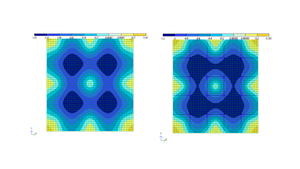
Calculation of flat reinforced concrete slabs strengthened by post-stressed rebars in two directions.
 Oleksandr Zhuravskyi 1* Ph.D., Associate Professor
Oleksandr Zhuravskyi 1* Ph.D., Associate Professor Vladyslav Tymoshchuk 1 Ph.D., Associate Professor
Vladyslav Tymoshchuk 1 Ph.D., Associate Professor
1 Department of Reinforced Concrete and Stone Structures of Kyiv National University of Construction and Architecture, Povitroflotskyi Avenue, 31, Kyiv, 03680, Ukraine;
Received: 11/20/2018, Accepted: 12/29/2018, Available online: 12/29/2018.
DOI: https://doi.org/10.32557/useful-2-4-2018-0007
HDL: https://hdl.handle.net/20.500.12334/91
*Corresponding author e-mail: azhur@ua.fm
Under a creative commons license. Volume 2, Issue 4, 2018, pages: 63-69.
Plagiarism was checked by Grammarly
Author Keywords: strengthening, flat reinforce concrete slab, external reinforcement, deformation, strength.
Abstarct
The purpose of the dissertation research is to carry out theoretical calculations and the experimental confirmation of the possibility of strengthening the flat reinforced concrete slabs with external stressed reinforcement, and influence of such strengthening on the subsequent operation of the slab under the increased load.
The results of theoretical researches of the calculation of flat reinforced concrete slabs strengthening by external stressed reinforcement in linear and nonlinear formulation of problems are presented, and the results of two calculation variants are compared.
1. Introduction.
During the arrangement of monolithic reinforced concrete flat roofs, problems with over-deflection and cracks occur. They can occur both during operation and during construction. The reasons that cause excessive deflections can be attributed to: deviation from manufacturing technology, design errors, etc. For large spans of monolithic plates (more than 6 m) it is recommended to use pre-stressed fittings. To reinforce reinforced concrete slabs you can use external tensile reinforcement, which will serve as external reinforcement. In the last 30-40 years, and in the countries of Europe and the United States, the use of pre-stresses with tension on concrete (post-stress) is becoming more and more successful, which allows an effectively pre-stressed monolith of construction. In our country, this technology has become widespread in the construction of monolithic overpasses and bridges, while civil construction is very rarely used. This is partly due to the lack of norms and recommendations for the calculation and design of these designs. In practice of modern construction, more and more are used pre-tensioned in two directions reinforced concrete slab structures. These include inter-floor overlays and coverage of public and industrial buildings, walls and roofs of tanks.
However, the study of such structures, working in conditions of a complex stressed state, is not exhaustive. Existing norms do not give concrete recommendations for the calculation of such a class of structures.
References
[1] Lira 9.4. User's Guide. Fundamentals: study. Way. / [IS. B. Strelets-Streletsky, V.E. Godovis, Yu.V.Genzersky and others.]. Kyiv: FACT, 2008. 164 p. (in Ukraine).
[2] Glukhovskiy A.D. Reinforced concrete flat floors for multi-storey buildings. Moscow, 1956. 62 p. (in Russian).
[3] Mikhailov V.V. Pre-stressed reinforced concrete structures. Moscow: Stroizdat, 1978. 383 p. (in Russian).
[4] Leonhardt F. Stress-reinforced concrete and its practical application. / per. Zhytomyrsky V. K. Moscow: Stroyizdat, 1957. 588 p. (in Russian).
[5] Zhuravsky O.D., Tymoshchuk V.A. Calculation of flat reinforced concrete slabs, strengthened with external stressed reinforcement. Building constructions. Theory and practice. Kyiv, KNUCA, 2017. Vol. 1. pp. 193-198 , (in Ukraine).
Please cite as: O. Zhuravskyi, V. Tymoshchuk “Calculation of flat reinforced concrete slabs strengthened by post-stressed rebars in two directions. ” USEFUL online journal, vol. 2, no. 4, pp. 63–69, December 2018. DOI: https://doi.org/10.32557/useful-2-4-2018-0007







Comments